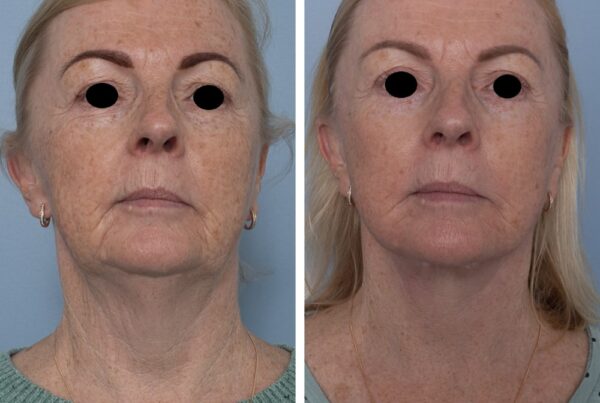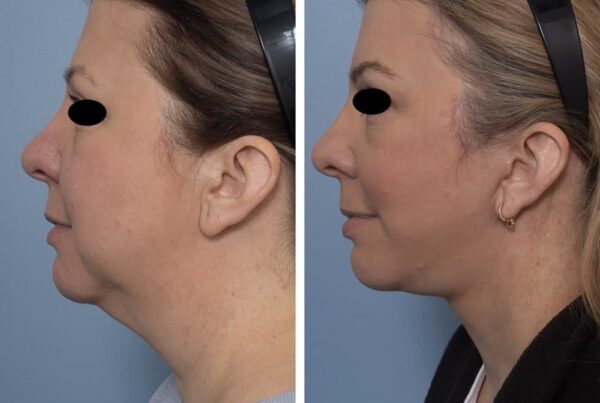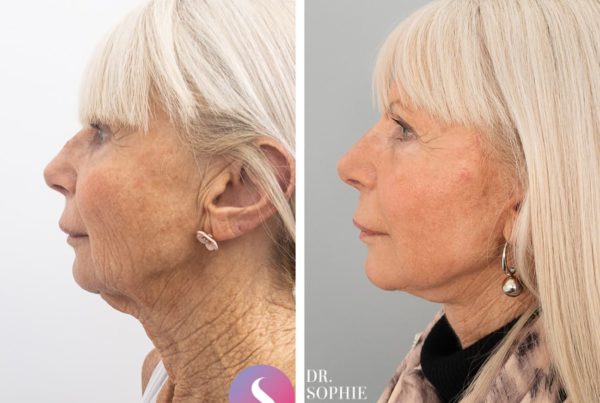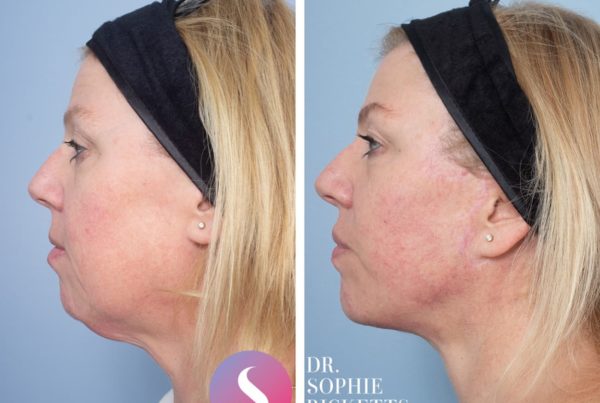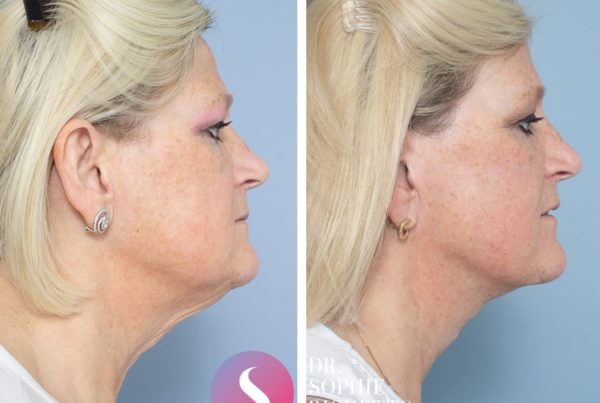Is Facelift surgery for you?
Face Lifts reverse the changes that have occurred to our faces through the effects of aging, sun damage and gravity.
Aging causes fat to shrink in critical places that once kept the skin plump and firm such as around the eyes and cheeks. Aging also shrinks our skeleton so the bony foundation of our face is no longer as strong. Sun damage leaves our skin crepey and gravity pulls the skin and soft tissue of the face downwards. Some parts of the face are stuck more firmly to the skeleton underneath than others and at these areas we see dark hollows and adjacent puffiness or drooping such as the jawline (‘jowls’) and the sides of the mouth (“nasolabial folds” and “marionette lines”).
About Face Lifts
Since the frightening wind-tunnel looks of the 80s techniques have evolved to be natural yet lasting with much shorter downtimes than some of the techniques of the 90s. As a result, we are seeing people benefiting from, and willing to undergo surgery at an earlier age.
Most importantly your surgeon must evaluate what your face needs as a whole. There are many adjunctive techniques such as neck lift, cheek implants and fat transfer that can be used to enhance your outcome.
What is the down-time?
The hospital stay is only one night and recovery time is around two weeks. By that time your bruising will be gone and with some light makeup you will look okay to go out. The cheeks feel firm and a little stiff to start with and soften over about 3-4 months.
What about the scars?
The scars are placed along the front of the ear and sideburn area and to a variable degree extend behind the ear too. With proper technique, the scars generally heal very well but if you are someone who wears their hair tied back a lot on close inspection the scar may be visible.
How long will my face lift last?
There are many factors that determine the longevity of a face lift including at what age you have it, your skin quality at the time, and the technique used. A good face lift should not only reverse the effects of time, but slow the future effects of aging. On average though, you should expect to see up to 10 years benefit from a face lift.
Neck Lift
We can all thank our parents for how we look. The neck is no exception. Some people are born with the genetics that will give them a less favourable neck. In profile or ‘side-on’ view we’d all like a well-defined jaw a chin-neck angle. Sometime genetics and excess fat in this area under the chin mean that the area under our chin and onto the neck are poorly defined and droopy.
Neck lift surgery removes fat, creates definition where the chin joins the neck and in conjunction with a facelift will tighten the skin along the front of the neck and jawline.
FAQ
How do I know if I need a necklift?
If you have excess skin, fat, or sagging in the neck area and are bothered by the appearance of visible jowls, a “turkey neck”, neckbands, or vertical lines, you may benefit from a neck lift. A consultation with a qualified plastic surgeon can help determine if this procedure is right for you. They can evaluate your skin elasticity, muscle tone, and other factors to develop a personalised treatment plan.
Does a necklift get rid of wrinkles?
A neck lift can tighten loose skin and remove excess fat from the neck, which can reduce the appearance of wrinkles to some extent. However, it’s not a specific wrinkle treatment, and other treatments like Botox or fillers may be more effective. A qualified plastic surgeon can help determine the most appropriate treatment plan for your individual needs.
Who is a good candidate for a necklift?
A good candidate for a neck lift is someone who is in good health, a non-smoker and has excess skin, fat, and sagging in the neck area, which can create an aged or tired appearance. It can be particularly beneficial for those who have experienced weight loss or aging. Realistic expectations and commitment to pre and post-operative instructions are necessary.
What is the best age to have a facelift?
The best age to have a facelift can vary depending on individual circumstances, and there is no one-size-fits-all answer. In general, people who are considering a facelift are typically in their 40s to 60s, but age is not the only factor to consider. The decision to have a facelift should be based on your personal goals and concerns as well as your overall health. The areas of your face that show signs of ageing first can vary depending on factors such as genetics, sun exposure and your underlying bone structure.
What are the benefits of a facelift?
A facelift can reduce signs of ageing, improve facial contours and symmetry, all with the goal of achieving a rejuvenated appearance. However, a facelift is a surgical procedure with potential risks and complications and may not be suitable for everyone. Consultation with a specialist plastic surgeon is important to determine if a facelift is the right option for each individual.
What to expect right after a facelift?
After a facelift, it is normal to experience some swelling, bruising, and discomfort. Here are some of the things you can expect during the immediate recovery period:
- Bandages and dressings: You may have dressings covering the sides of your face and neck to protect the incisions and reduce swelling. These may be removed after a day or two.
- Swelling and bruising: Swelling and bruising are common after a facelift and may last for several weeks. Applying cold compresses to the affected areas can help reduce swelling and discomfort.
- Pain and discomfort: It is common to experience some pain and discomfort after a facelift. Most patients do not find the pain is severe, rather a feeling of tightness. You will be prescribed pain medication to help manage this.
- Drainage tubes: You may have small, soft drainage tubes placed near the incision sites to prevent fluid buildup. These are typically removed the day after your surgery.
- Follow-up appointments: You will have follow-up appointments with your surgeon to monitor your progress and remove any sutures that were used to close the incisions. The first appointment is usually about a week after surgery.
- Rest and recovery: It is important to rest and avoid strenuous activities for several weeks after a facelift to allow your body time to heal.
It’s important to follow your surgeon’s post-operative instructions carefully to ensure a smooth and successful recovery. If you experience any unusual symptoms or have any concerns, contact the practice and speak with our nurse or Dr Ricketts.
